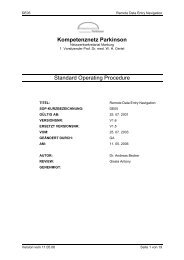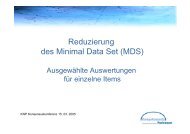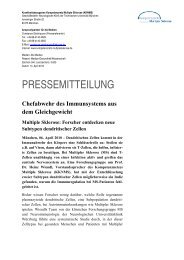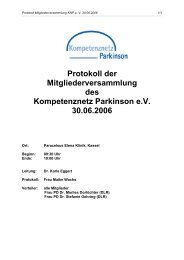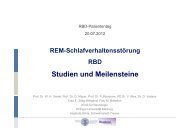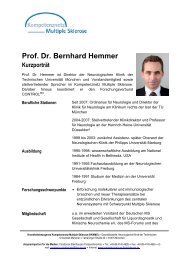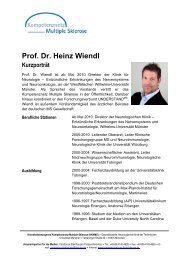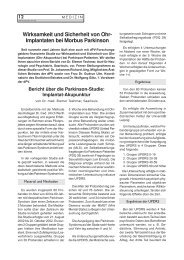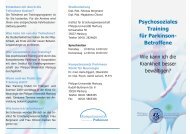Pathophysiology of Migraine - Kompetenznetz Parkinson
Pathophysiology of Migraine - Kompetenznetz Parkinson
Pathophysiology of Migraine - Kompetenznetz Parkinson
You also want an ePaper? Increase the reach of your titles
YUMPU automatically turns print PDFs into web optimized ePapers that Google loves.
the dura mater, the intracranial segments <strong>of</strong> the trigeminal,<br />
the vagus, and glossopharyngeal nerves, and the<br />
proximal portions <strong>of</strong> the large intracranial vessels including<br />
the basilar, vertebral, and carotid branches, 2,3 are<br />
highly pain-sensitive structures. Depolarization <strong>of</strong> small<br />
caliber pseudounipolar neurons projecting from the<br />
trigeminal ganglion, which invest these meningeal structures<br />
and cerebral vessels, 4 results in activation <strong>of</strong><br />
second-order neurons within the brainstem areas <strong>of</strong> the<br />
medullary trigeminal nucleus caudalis (TNC) and the<br />
dorsal horn <strong>of</strong> upper cervical spinal cord segments. 5<br />
Stimulation <strong>of</strong> trigeminal nociceptive neurons results<br />
in activation patterns, organized somatotopically along<br />
the rostrocaudal axis <strong>of</strong> the brainstem 6 in a pattern<br />
consistent with the classical ‘‘onionskin’’ distribution<br />
seen in the sensory deficits experienced in patients after<br />
trigeminal tractotomy. Once activated, second-order<br />
neurons in the TNC and cervical dorsal horn are<br />
modulated by projections from the nucleus raphe magnus,<br />
periaqueductal gray, 7 rostral trigeminal nuclei, 8 and<br />
descending cortical inhibitory systems. 9 These activated<br />
second-order neurons project to other brainstem nuclei,<br />
10,11 as well as the contralateral dorsomedial and<br />
ventroposteromedial nuclei <strong>of</strong> the thalamus. 6 Trigeminal<br />
pain is also associated with activation in several cortical<br />
areas, including the insular cortex, anterior cingulate<br />
cortex, and somatosensory cortex. 12 In the primary<br />
somatosensory cortex, trigeminal painful stimulation<br />
results in a laminar configuration similar to that observed<br />
within the brainstem trigeminal nuclei with V1 more<br />
caudal, V2 more rostral, and V3 medial, abutting the<br />
area <strong>of</strong> activation observed after stimulation <strong>of</strong> the<br />
thumb. 6<br />
Traditional Theories <strong>of</strong> <strong>Migraine</strong> Pathogenesis:<br />
Brain versus Vessel<br />
Two competing theories dominated the discussion <strong>of</strong><br />
migraine pathogenesis throughout the 20th century. The<br />
vasogenic theory, which viewed migraine as a form <strong>of</strong><br />
vascular dysregulation and assumed that the aura was<br />
due to a transient vasoconstriction-induced hypoxemia,<br />
dominated the discussion until the 1980s. According to<br />
the vasogenic theory, migraine headache was caused by a<br />
rebound vasodilation that resulted in a mechanical depolarization<br />
<strong>of</strong> primary nociceptive neurons within the<br />
walls <strong>of</strong> engorged intra- and extracerebral vessels. 13 One<br />
<strong>of</strong> the mainstays <strong>of</strong> the vasogenic theory was the fact that<br />
it was consistent with the observed headache inducing<br />
effects <strong>of</strong> vasodilating drugs, such as nitroglycerin, and<br />
the therapeutic effects <strong>of</strong> ergotamines, which were<br />
known to be potent vasoconstrictors. Reports <strong>of</strong> no<br />
efficacy from the nonvasoconstrictive substance P antagonists<br />
in acute migraine also seemed to favor the vasogenic<br />
hypothesis. 14 However, recent imaging studies<br />
revealed that the headache induced by nitroglycerin<br />
PATHOPHYSIOLOGY OF MIGRAINE/CUTRER 121<br />
begins well after the resolution <strong>of</strong> vasodilation when<br />
vessels are at their normal baseline caliber. 15,16 In addition,<br />
other vasodilating substances, like vasoactive intestinal<br />
peptide, do not induce migraine headache. 17<br />
The alternative neurogenic theory viewed migraine<br />
as a disorder <strong>of</strong> the brain in which vascular<br />
changes were the result <strong>of</strong> neuronal dysfunction. Proponents<br />
<strong>of</strong> this theory pointed to the fact that multiple<br />
neurologic symptoms <strong>of</strong>ten occur during a single aura<br />
that are difficult to localize within a single neurovascular<br />
territory. Also in favor <strong>of</strong> the neurogenic theory were<br />
findings from neuroimaging studies conducted during<br />
spontaneous, classical visual auras, which indicated that<br />
the decreases in cortical blood flow observed during aura<br />
are not sufficient to cause ischemia, and that subsequent<br />
vasodilation does not take place until well after the onset<br />
<strong>of</strong> headache. 18–20 In addition, multiple nonvasoconstrictive<br />
treatments are known to be effective in migraine. 21<br />
Unfortunately, at this point in time, if viewed rigidly,<br />
neither theory alone can account for all <strong>of</strong> the clinical and<br />
treatment response characteristics <strong>of</strong> migraine.<br />
Genetic Factors<br />
There is accumulating evidence that migraine is a complex<br />
genetic disorder. The influence <strong>of</strong> inheritance in<br />
migraine has long been recognized. Over the past several<br />
years, investigators have identified three distinct single<br />
gene defects that may account for familial hemiplegic<br />
migraine (FHM), a rare autosomal dominantly inherited<br />
form <strong>of</strong> migraine. The first defect to be identified was for<br />
FHM type 1 and was found in a gene known as<br />
CACNA1A located on chromosome 19p13. CAC-<br />
NA1A codes for the a 1 -subunit <strong>of</strong> a brain specific<br />
voltage-gated P/Q-type calcium channel. 22 A second<br />
defect (linked to FHM type 2) has been identified on<br />
chromosome 1q23 in the ATP1A2 gene that encodes<br />
the a 2 -subunit <strong>of</strong> a Na þ /Kþ pump. 23 More recently, a<br />
third mutation on chromosome 2q24 has been associated<br />
with FHM type 3. This mutation occurs in the voltagegated<br />
sodium channel SCN1A. 24 At least 17 different<br />
mutations within the CACNA 1A have been linked to<br />
migraine or other related clinical syndromes. In addition<br />
to unilateral motor weakness, patients with FHM experience<br />
typical visual, sensory, and/or language auras with<br />
some attacks <strong>of</strong> FHM. Just as in the more common<br />
forms <strong>of</strong> migraine, FHM is more common in women<br />
than in men, possibly implicating hormonal shifts in<br />
migraine pathogenesis.<br />
Linkage analysis and various association studies<br />
have implicated numerous polymorphisms in the more<br />
common forms <strong>of</strong> migraine: migraine with aura (MA)<br />
and migraine without aura (MO). It is increasingly<br />
evident that the common forms <strong>of</strong> migraine are based<br />
on complex, heterogeneic genetics (Table 1). The obvious<br />
complexity <strong>of</strong> the underlying genetics will likely be<br />
Downloaded by: Universitätsbibliothek Marburg. Copyrighted material.





